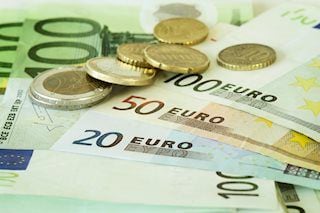EUR/USD appreciates to near 1.0850 despite less-dovish sentiment surrounding the Fed
|
- EUR/USD may struggle as solid US Retail Sales data reinforces the odds that the Fed may deliver nominal rate cuts.
- CME FedWatch Tool suggests a 90.8% and 74.0% chance of a 25 basis point rate cuts in November and December, respectively.
- The Euro depreciated as the ECB reduced its Rate on Deposit Facility to 3.25%.
The EUR/USD pair breaks its four-day losing streak, trading around 1.0840 during the Asian session on Friday. However, the US Dollar (USD) received support and reached a two-month high of 103.87 on Thursday, supported by a solid US Retail Sales report, which fueled expectations that the Federal Reserve (Fed) may implement nominal rate cuts.
According to the CME FedWatch Tool, there is a 90.8% probability of a 25 basis point rate cut in November and a 74.0% chance of another cut in December.
US Retail Sales rose by 0.4% month-over-month in September, surpassing both the 0.1% gain recorded in August and market expectations of a 0.3% increase.
US Initial Jobless Claims fell by 19,000 during the week ending October 11, the largest decline in three months. The total number of claims dropped to 241,000, significantly below the anticipated 260,000.
However, the Euro faced downward pressure following the European Central Bank's (ECB) policy decision on Thursday.
The ECB reduced its Main Refinancing Operations Rate and the Rate on Deposit Facility by 25 basis points to 3.40% and 3.25%, respectively, as expected by market participants.
This marks the first back-to-back rate cut by the ECB in 13 years, bringing the Deposit Facility rate down to 3.25%. The move follows a significant decline in inflation, which peaked at 10.6% in October 2022 and dropped to 1.7% in September—below the ECB’s 2% target.
During the post-meeting conference, ECB President Christine Lagarde left markets uncertain about the timing of future rate cuts, while stating that the Eurozone economy was on track for a soft landing.
Euro FAQs
The Euro is the currency for the 19 European Union countries that belong to the Eurozone. It is the second most heavily traded currency in the world behind the US Dollar. In 2022, it accounted for 31% of all foreign exchange transactions, with an average daily turnover of over $2.2 trillion a day. EUR/USD is the most heavily traded currency pair in the world, accounting for an estimated 30% off all transactions, followed by EUR/JPY (4%), EUR/GBP (3%) and EUR/AUD (2%).
The European Central Bank (ECB) in Frankfurt, Germany, is the reserve bank for the Eurozone. The ECB sets interest rates and manages monetary policy. The ECB’s primary mandate is to maintain price stability, which means either controlling inflation or stimulating growth. Its primary tool is the raising or lowering of interest rates. Relatively high interest rates – or the expectation of higher rates – will usually benefit the Euro and vice versa. The ECB Governing Council makes monetary policy decisions at meetings held eight times a year. Decisions are made by heads of the Eurozone national banks and six permanent members, including the President of the ECB, Christine Lagarde.
Eurozone inflation data, measured by the Harmonized Index of Consumer Prices (HICP), is an important econometric for the Euro. If inflation rises more than expected, especially if above the ECB’s 2% target, it obliges the ECB to raise interest rates to bring it back under control. Relatively high interest rates compared to its counterparts will usually benefit the Euro, as it makes the region more attractive as a place for global investors to park their money.
Data releases gauge the health of the economy and can impact on the Euro. Indicators such as GDP, Manufacturing and Services PMIs, employment, and consumer sentiment surveys can all influence the direction of the single currency. A strong economy is good for the Euro. Not only does it attract more foreign investment but it may encourage the ECB to put up interest rates, which will directly strengthen the Euro. Otherwise, if economic data is weak, the Euro is likely to fall. Economic data for the four largest economies in the euro area (Germany, France, Italy and Spain) are especially significant, as they account for 75% of the Eurozone’s economy.
Another significant data release for the Euro is the Trade Balance. This indicator measures the difference between what a country earns from its exports and what it spends on imports over a given period. If a country produces highly sought after exports then its currency will gain in value purely from the extra demand created from foreign buyers seeking to purchase these goods. Therefore, a positive net Trade Balance strengthens a currency and vice versa for a negative balance.
Information on these pages contains forward-looking statements that involve risks and uncertainties. Markets and instruments profiled on this page are for informational purposes only and should not in any way come across as a recommendation to buy or sell in these assets. You should do your own thorough research before making any investment decisions. FXStreet does not in any way guarantee that this information is free from mistakes, errors, or material misstatements. It also does not guarantee that this information is of a timely nature. Investing in Open Markets involves a great deal of risk, including the loss of all or a portion of your investment, as well as emotional distress. All risks, losses and costs associated with investing, including total loss of principal, are your responsibility. The views and opinions expressed in this article are those of the authors and do not necessarily reflect the official policy or position of FXStreet nor its advertisers.